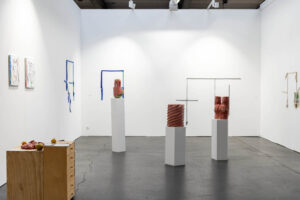Wobbe Micha: Throughout recent summers Wobbe Micha has dedicated himself to an ongoing series of ceramic sculptures. In these works, Micha carves intricate forms directly into the flesh of watermelons. Immediately after completion, a plaster cast is meticulously made, allowing the subject to be re-erected in clay.
Pigmented glazes lend a captivating touch to these sculptures, the vibrant contrast of red and green hues accentuates the inherent allure of the watermelon’s seeded flesh.
As the season draws to a close and the last remnants of buzzing flies fade away, Micha brings his vision to fruition, creating a collection that encapsulates the fleeting nature of life and memory.
Joke Robaard: With the series Se-lections, Joke Robaard transfers structures that govern clothing to the structure of language: the visible substance – the fabric – disappears and the invisible – the seam, the dividing line, which creates coherence – becomes substance. The seam is cut out, the rest is cut away, the invisible structure becomes visible form. There is only a cut out path, everything else is gone. From that moment on it is possible to see right through these skeletal structures and speculate about the intentions and gestures of the wearer. The objects or actors appear to point left or right, raise their hands, fall, turn. Just as letters are created from a grid, these works arise from an event, a situation. This series was initiated in 1978/1979 and continued in 2020.
The work of Joke Robaard (Meppel, 1953) is an ongoing investigation into the representation of people, as they emerge in groups and networks. Her photo works, canvases, videos and diagrams reflect the changes and shifts in the connections between people, clothing and language. Since 1978, Robaard has been working on an extensive image archive consisting of thousands of pages and clippings from magazines and newspapers. Together with writer Camiel van Winkel, she published the book ARCHIVE SPECIES, Bodies, Habits, Practices. In it she inventories and questions strategies of represented humanity.










